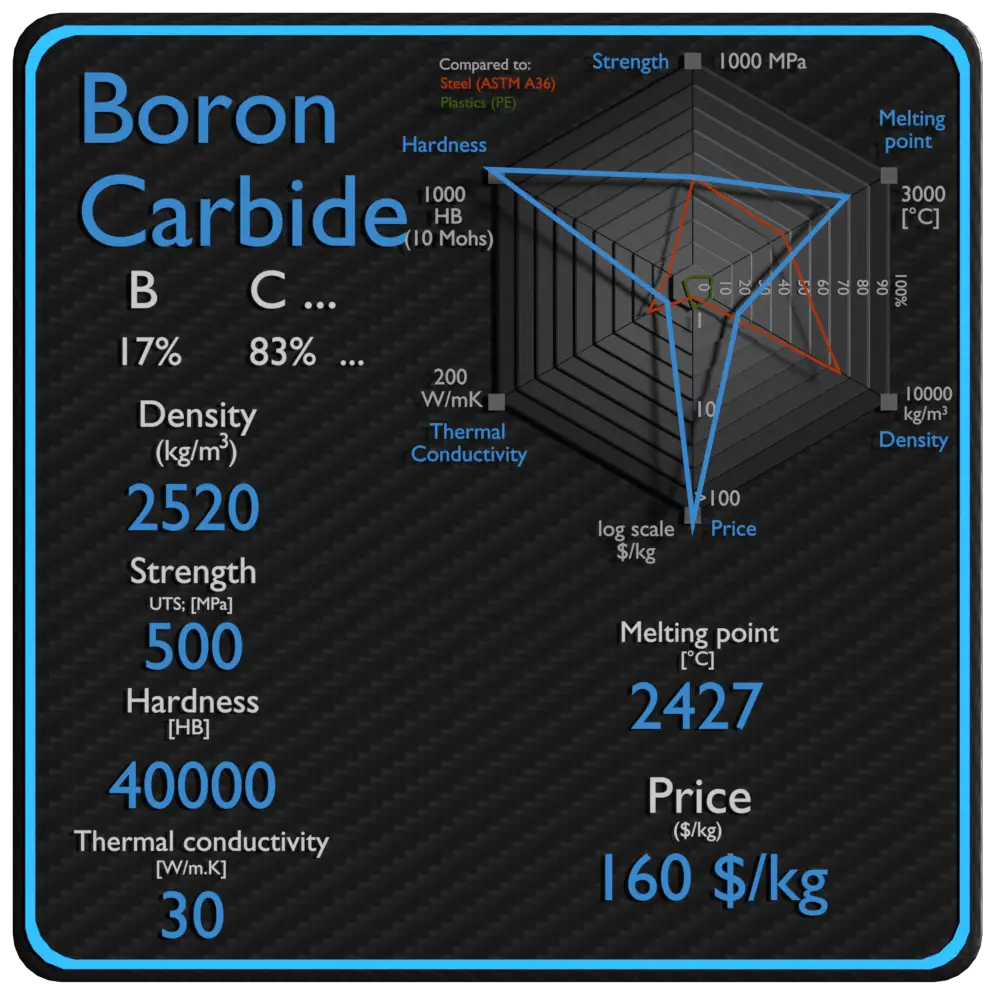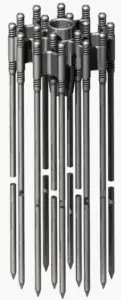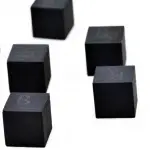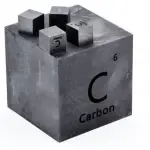About Boron Carbide
Boron carbide (chemical formula approximately B4C) is an extremely hard boron–carbon ceramic and covalent material. It is one of the hardest materials known, ranking third behind diamond and cubic boron nitride. It is the hardest material produced in tonnage quantities.

Summary
| Name | Boron Carbide |
| Phase at STP | solid |
| Density | 2520 kg/m3 |
| Ultimate Tensile Strength | 500 MPa |
| Yield Strength | N/A |
| Young’s Modulus of Elasticity | 460 GPa |
| Brinell Hardness | 40000 BHN |
| Melting Point | 2427 °C |
| Thermal Conductivity | 30 W/mK |
| Heat Capacity | 1000 J/g K |
| Price | 160 $/kg |
Composition of Boron Carbide
Boron carbide, (B4C), crystalline compound of boron and carbon. Boron carbide has a complex crystal structure typical of icosahedron-based borides.
Applications of Boron Carbide

Due to its high hardness, boron carbide powder is used as an abrasive in polishing and lapping applications, and also as a loose abrasive in cutting applications such as water jet cutting. Because of its hardness, together with its very low density, it has found application as a reinforcing agent for aluminum in military armour and high-performance bicycles, and its wear resistance has caused it to be employed in sandblasting nozzles and pump seals. Boron carbide is also used in control rods in nuclear reactors.
Mechanical Properties of Boron Carbide
Strength of Boron Carbide
In mechanics of materials, the strength of a material is its ability to withstand an applied load without failure or plastic deformation. Strength of materials basically considers the relationship between the external loads applied to a material and the resulting deformation or change in material dimensions. In designing structures and machines, it is important to consider these factors, in order that the material selected will have adequate strength to resist applied loads or forces and retain its original shape.
Strength of a material is its ability to withstand this applied load without failure or plastic deformation. For tensile stress, the capacity of a material or structure to withstand loads tending to elongate is known as ultimate tensile strength (UTS). Yield strength or yield stress is the material property defined as the stress at which a material begins to deform plastically whereas yield point is the point where nonlinear (elastic + plastic) deformation begins. In case of tensional stress of a uniform bar (stress-strain curve), the Hooke’s law describes behaviour of a bar in the elastic region. The Young’s modulus of elasticity is the elastic modulus for tensile and compressive stress in the linear elasticity regime of a uniaxial deformation and is usually assessed by tensile tests.
See also: Strength of Materials
Ultimate Tensile Strength of Boron Carbide
Ultimate tensile strength of Boron Carbide is 500 MPa.
Yield Strength of Boron Carbide
Yield strength of Boron Carbide is N/A.
Modulus of Elasticity of Boron Carbide
The Young’s modulus of elasticity of Boron Carbide is 460 MPa.
Hardness of Boron Carbide
In materials science, hardness is the ability to withstand surface indentation (localized plastic deformation) and scratching. Brinell hardness test is one of indentation hardness tests, that has been developed for hardness testing. In Brinell tests, a hard, spherical indenter is forced under a specific load into the surface of the metal to be tested.
The Brinell hardness number (HB) is the load divided by the surface area of the indentation. The diameter of the impression is measured with a microscope with a superimposed scale. The Brinell hardness number is computed from the equation:
Brinell hardness of Boron Carbide is approximately 40000 BHN (converted).
See also: Hardness of Materials
Thermal Properties of Boron Carbide
Boron Carbide – Melting Point
Melting point of Boron Carbide is 2427 °C.
Note that, these points are associated with the standard atmospheric pressure. In general, melting is a phase change of a substance from the solid to the liquid phase. The melting point of a substance is the temperature at which this phase change occurs. The melting point also defines a condition in which the solid and liquid can exist in equilibrium. For various chemical compounds and alloys, it is difficult to define the melting point, since they are usually a mixture of various chemical elements.
Boron Carbide – Thermal Conductivity
Thermal conductivity of Boron Carbide is 30 W/(m·K).
The heat transfer characteristics of a solid material are measured by a property called the thermal conductivity, k (or λ), measured in W/m.K. It is a measure of a substance’s ability to transfer heat through a material by conduction. Note that Fourier’s law applies for all matter, regardless of its state (solid, liquid, or gas), therefore, it is also defined for liquids and gases.
The thermal conductivity of most liquids and solids varies with temperature. For vapors, it also depends upon pressure. In general:
Most materials are very nearly homogeneous, therefore we can usually write k = k (T). Similar definitions are associated with thermal conductivities in the y- and z-directions (ky, kz), but for an isotropic material the thermal conductivity is independent of the direction of transfer, kx = ky = kz = k.
Boron Carbide – Specific Heat
Specific heat of Boron Carbide is 1000 J/g K.
Specific heat, or specific heat capacity, is a property related to internal energy that is very important in thermodynamics. The intensive properties cv and cp are defined for pure, simple compressible substances as partial derivatives of the internal energy u(T, v) and enthalpy h(T, p), respectively:
where the subscripts v and p denote the variables held fixed during differentiation. The properties cv and cp are referred to as specific heats (or heat capacities) because under certain special conditions they relate the temperature change of a system to the amount of energy added by heat transfer. Their SI units are J/kg K or J/mol K.
Properties and prices of other materials
material-table-in-8k-resolution










